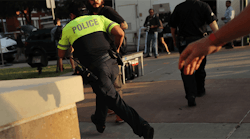On Friday morning, the Dallas police chief, David Brown, said officers used a robot to set off an explosive, killing a suspect in the shooting deaths of five police officers after failing to persuade him to surrender. The act raised uncomfortable questions at a time of increasing concern about the police using sophisticated technology that was once employed exclusively in war zones.
The details of the incident are still emerging, but it’s clear that the robot used in this operation was far from the killer droids of science fiction. Police deployed a small machine typically used to investigate dangerous situations or defuse bombs; it was more akin to a sophisticated remote-control car than drones used by the military. An explosive was affixed to the robot and detonated. The Dallas Police Department declined to comment further.
In Iraq, soldiers have attached mines to similar robots and used them to kill insurgents. But domestic police forces have never employed such a tactic, according to Peter Singer, a senior fellow at the New America Foundation, and Arthur Holland Michel, the co-director of Bard University’s Center for the Study of the Drone.
This is not the first time police have used a bomb to kill someone in the middle of a large American city. In 1985 the police dropped a bomb on a house in Philadelphia serving as a headquarters for a group of black liberationists, killing 11 people, including four children, and setting fire to dozens of nearby homes. That incident is now seen more like an aberration in the history of police violence than a turning point.
While the Dallas event is also an outlier, the worry is that it could be a harbinger.
"I hope they don’t start designing a whole series of police-armed robots," said Peter Asaro, who studies the ethical implications of military robotics and drones at The New School. "Once it becomes standard practice, it’ll be used in other instances that aren’t as cut and dry as this one."
The police use of robots in and of itself isn’t novel. Bomb squads have been using them for decades, and hundreds of police departments in the U.S. own robots, ranging from tiny devices that can be thrown into a room to look around to larger ones designed to disarm bombs.
The types of missions robots have been used for escalated after the 9/11 terrorist attacks, when technology used in Iraq and Afghanistan were transferred to domestic police departments, according to Jeffrey Dade, commander of the New Hampshire State Police Bomb Squad.
The biggest supplier of police robots is Endeavor Robotics, which claims to have fielded over 6,000 of the machines. The company’s website makes no mention of putting weapons on any of its products. Other vendors include Remotec, a subsidiary of Northrop Grumman, and RoboteX.
Many police departments use robots they’ve acquired through a program that passes on equipment once used by the military.
The Dallas police department has been particularly enthusiastic about procuring robots, according to Michel. It received three shipments of robots through the military hand-me-down program in the spring of 2014, according to Michel’s review of public documents.
Last June, a man opened fire on Dallas police headquarters and planted explosives outside the building. Robots attempted to disarm a bomb, which exploded and inspected the man’s van during the ensuing standoff.
Not everyone thinks that a bomb delivered by a robot raises any novel issues related to the use of lethal force. “How different is it than if the officer shot this guy?” says Jim Bueermann, president of the Police Foundation. “At some point, they made the decision to use deadly force to stop what they were doing. That was either in returning fire, trying to get their own marksman in place, or blowing it up with a bomb.”
But there is a widespread feeling that there is a difference between a robot killing someone and a cop pulling the trigger.
Several states have passed bans on putting weapons on drones. “I can confidently say that there is a broad consensus that armed domestic drones are beyond the pale,” Jay Stanley of the American Civil Liberties Union wrote in a blog post last year. Stanley was writing to criticize a North Dakota law passed last year banning the use of lethal weapons on unmanned aircraft, without extending that ban to non-lethal weapons like tear gas or rubber bullets.
There is no legal difference between using a gun and using a robot to kill someone, Stanley said, but there are practical differences. "Because ground robots may allow deadly force to be applied more safely and easily, they raise the danger that they will be over-used," he said. "When things get easier to do, they tend to be done too much."
In addition to any legal or ethical issues, the Dallas case raises questions about whether police robots are secure enough to carry lethal weapons, says Jonathan Zdziarski, a cybersecurity researcher who consults with law enforcement. The systems often use wireless connections that could easily be compromised. "You set a robot loose with a bomb, what controls are in place to make sure that nobody can hijack that connection?” he said.
Other police departments have expressed at least passing interest in using robots to deploy lethal force, says Eric Ivers, the president of RoboteX, which provides robots to over 500 police departments in the U.S. He says potential customers periodically ask whether it’s possible to attach guns or other weapons to robots. He says he tells them it’s technically possible and asks whether that’s something they would actually want to do. “It’s an easy way to find out if they’re serious,” he said. "They never are."
Ivers says he’s shocked that Dallas police would use a robot to kill someone. “That is the absolute opposite of what these robots are used for. They’re used to save lives on both sides,” he said. “It’s a terrible thing to do with a robot.”











